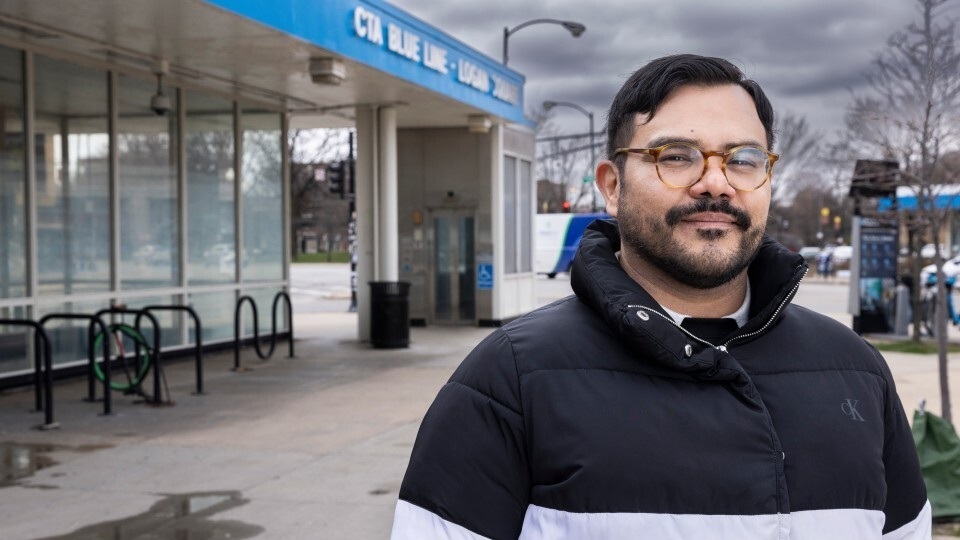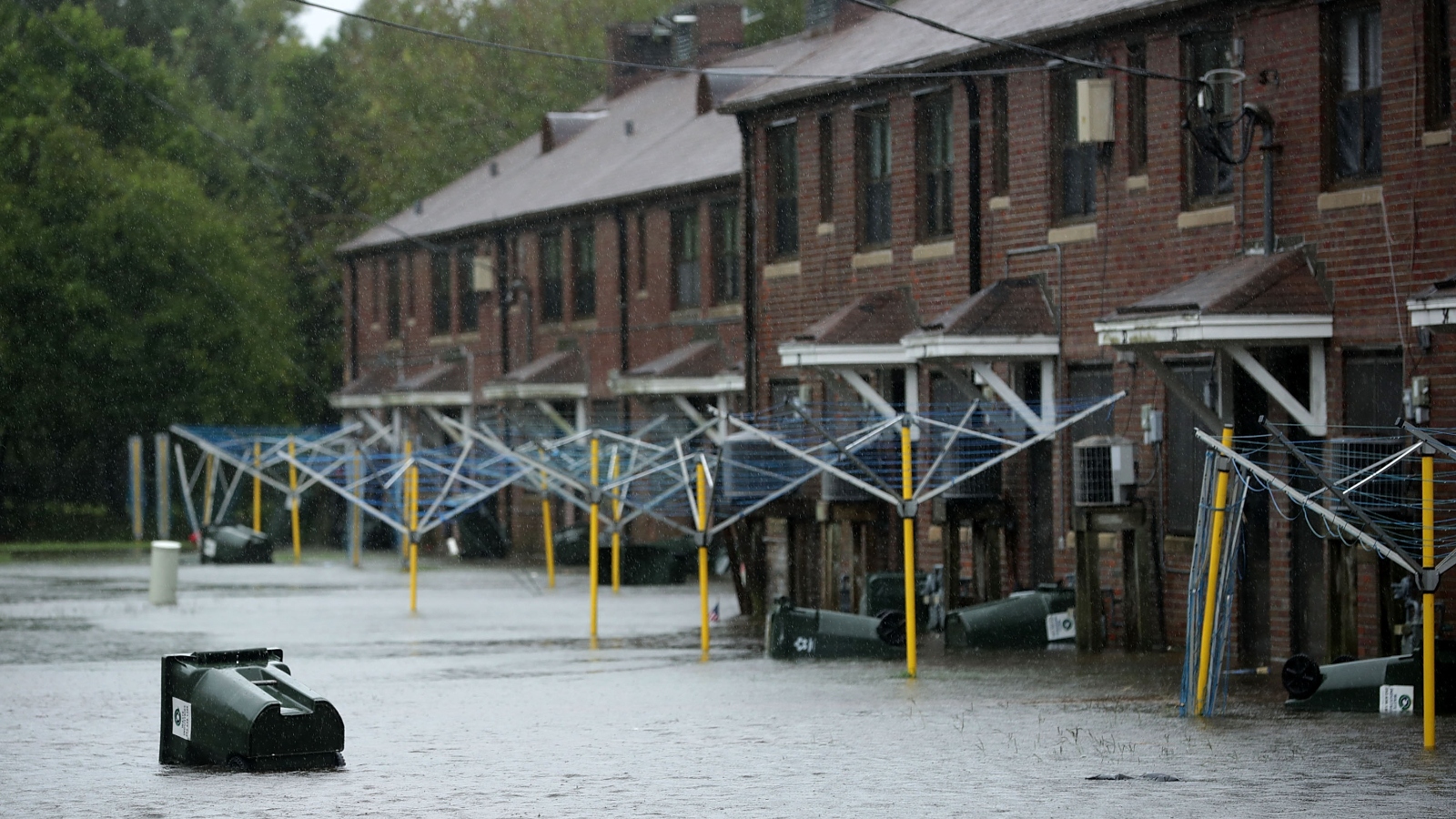
This coverage is made possible through a partnership between WBEZ and Grist, a non-profit environmental media organization. Sign Up for WBEZ newsletters to get local news you can trust.
Christian Diaz hates a boxy, six-story brick building with blue and gray panels in Logan Square, a fast-growing neighborhood on Chicago’s northwest side.
“It looks boring and uninspired,” says Diaz, the housing director at Palenque LSNA, formerly known as the Logan Square Neighborhood Association. “When people think of gentrification, this is the building that comes to mind.”
The building is an example of what urban planners call Transit Oriented Development, or TOD. The idea is that the development of nearby transport leads to interconnected communities and fewer cars that emit carbon dioxide. Developers get incentives and neighbors get a walkable community. But Diaz said buildings like these — dense, high-rise developments that cater to wealthy tenants — are accelerating gentrification in the once working-class, largely Latino neighborhood. Only three of the 60 units qualify as affordable housing.
“This building, thumbs down — 100 percent thumbs down,” Diaz said.
Instead, housing advocates like Diaz want TOD to evolve and become a tool to make Logan Square accessible to everyone — and to help reclaim it for people pushed out by gentrification.
“The irony is that in the pursuit of more walkable cities, we’re actually making it so that people of color in general have to be more reliant on cars,” Diaz said. As longtime residents are pushed further and further from the city, he points out, access to public transportation is limited and cars become inevitable.
The development of residential buildings near transit stops was seen by planners as a shortcut to greener, more efficient cities. But across the country, the idea slowly took off. A recent one analysis of the Urban Institute, a Washington DC think tank, found that while growth near transit has expanded over the past twenty years compared to previous decades, it’s still not enough.
The analysis found that nearly nine times as many housing units have been added far from transit stations than near them over the past two decades.
“There are two big reasons for that: One is that we haven’t built enough public transportation for the people who need it,” says Yonah Freemark, a principal research fellow at the Urban Institute. “And the second is, we continue to allow development well into the suburbs, suburban areas.”
Suburban and suburban sprawl will mean more driving, more congestion and more carbon emissions in Chicago and other big cities, according to Freemark.
Diaz’s fight in Chicago isn’t easy, but his group is starting to score some victories with new affordable housing and public spaces. In the end, success will mean linking a drive for affordable housing to the increasingly clear need for sustainable and climate-resilient cities.

Manuel Martinez/WBEZ
TOD as one solution took off in earnest in Chicago around 2013 after the City Council passed an ordinance encouraging developers to build near transit. It was a race-neutral policy that resulted little activity on the South and West sides. But outside the train stations in Logan Square, for example, that meant luxury housing that left out moderate and low-income families. In 2019, the city updated the ordinance to ensure that a racial analysis is baked into any project.
“We don’t want walkable neighborhoods just for affluent individuals,” said Janice Newsoncoordinator for Elevated Chicagoa coalition of nonprofits and city agencies trying to promote equity in Transit Oriented Development by making sure affordable housing is part of the equation.
TOD has thrived in hot markets, according to Kate Lowea professor of urban planning at the University of Illinois, Chicago.
“That’s the thing,” Lowe said. “When we rely on the private sector, we are going to see profit-driven actions.”
The market in Logan Square is hot. The price of a single house can cost $1 million. Luxury retail dot the Milwaukee Avenue corridor, the key diagonal road that bisects the neighborhood. Since 2001, nearly half of Logan Square’s Latino population has been displaced and replaced by mostly white and upwardly mobile residents. To count as affordable housing, residents’ income must be at or below 60 percent of the area median income. In Chicago, for a family of four who to $66,180.
Logan Square is still gentrified, but parts of the neighborhood are getting closer to transit and starting to feel like home again. Soon, the streetscape around the Logan Square Blue Line train station will be redesigned.
“We are going to have more green space, we are going to have La Placita,” Diaz said.
La Placita – Spanish for plaza – arose from discussions with residents who wanted a Latin American-inspired public square. The development is part of a major traffic redesign of the neighborhood that has been years in the planning. Construction will begin in the coming months.
“I can’t wait, in two years, to call my mom on a Sunday morning and say, ‘Hey mom, vamos a la placita,’ and we can just walk down the street in Logan Square,” Diaz said.
It’s not just green space. Palenque LSNA is also working on the development of 10 murals on neighborhood schools that commemorate the history and culture of the neighborhood.
“As we develop this new open, walkable space for the community, our hope is that the kids will eventually come to La Placita and say, ‘Oh, wow, that’s the mural from my school. This plaza is for me.’ ”
Diaz is proud of the work his organization and other local partners have accomplished. He said it was proof that it was possible to fight – and possible to win.
“We’re here to stay part of the neighborhood,” Diaz said. “A significant portion of the neighborhood, especially downtown, next to the Logan Square Blue Line station, will always be working class people and people of color.”
Right near where La Plazita sat down, Diaz adjusted his glasses and pointed to a modern seven-story building. On a former parking lot, near a train stop, a development called the Lucy Gonzalez Parsons Apartment Building has 100 units — all affordable housing.
“This one gets two thumbs up,” Diaz said.





